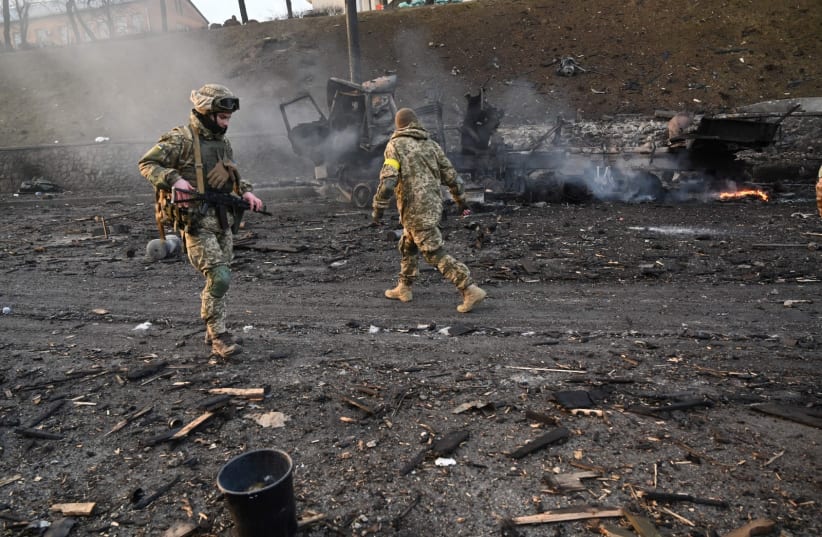As the war in Ukraine entered its fourth day, there were many questions about how it was going and how it developed. Russian forces were trying to break into Kyiv and trying to take the large city of Kharkiv in eastern Ukraine. In addition, Russian forces were trying to encircle Mariupol on the Black Sea and perhaps were heading toward Odessa.
However, the rapidly changing battlefield has not always been accompanied by the kind of video footage that we have become used to in recent modern wars. Ever since the Gulf War of 1991, it was common to receive daily updates from the front line and what was happening in the conflict.
The explosion of more smartphones among average people has meant it is very hard for militaries to keep anything entirely secret. In addition, the media have had good access to both sides of conflicts since the era of television dawned and the Vietnam war was broadcast into people’s living rooms in the US.
Read more on the Russia-Ukraine War:
- Day 4 of the Russian invasion of Ukraine
- Status of negotiations between Russia and Ukraine
- 'Israel trying to maintain option to mediate between Ukraine and Russia’
- Zelensky calls on foreigners to join in war against Russia
- Snake Island soldiers who told Russian ship to 'f*** itself' may still be alive
However, when it comes to Ukraine, there actually isn’t much footage from major media of fighting on most of the front lines. While there are news teams in Kyiv and in Lviv, there is generally a lack of coverage of many of the front lines. This includes a lack of coverage of the Donbas front opposite Donetsk, as well as a lack of coverage of what is happening along the Crimea front as Russia has tried to push into southern Ukraine.
One reason for the lack of coverage may be because the war has developed along thousands of kilometers of front. With at least four major Russian thrusts into Ukraine, media can’t be at every place at the right time.
It also appears that before the war, many media could not receive permission to enter the area along the Donbas front, which Ukraine used to refer to at the “Anti-Terrorist Operation,” or ATO. That kept journalists in Kyiv or sometimes in Lviv. Most of them were in Kyiv when the war broke out, and as the war worsened, some left areas like Kharkiv and Kyiv and went to Lviv or to Poland.
On the Russian side, there have been no international media embeds with Russian forces, and Russian forces have generally appeared to not want media with them, for fear that media will show how they have performed on the first days of the conflict. That means coverage is mostly relegated to the Ukrainian side of the war.
While many have commented on how Ukraine has done a good job in the information war, issuing statements about its successes and resistance and receiving positive coverage abroad, there is evidence that Ukraine has also put in place good operational security features to keep journalists and average people from covering the widespread war on the front. That certainly saves lives of journalists. It also appears that for the average Ukrainian, there is a widespread understanding of not sharing video of where soldiers are located.
There have been reports in Ukraine about attempts by the authorities to keep Russia from exploiting communications to its benefit. One report on Saturday said Ukraine had told people to turn off geolocation on cellphones. This may be no small matter because some had spotted the Russian invasion the night it happened due to traffic jams appearing on Google maps, apparently indicating that Russian armored columns were moving into position. In other instances, the road closures inside Ukraine have allegedly indicated some of the areas of clashes on Google.
Meanwhile, for many civilians, it seems curfews and other measures are keeping them from doing too much filming of the fighting. There have been remarkable videos of Russian helicopter air assaults, armored vehicles driving through towns and in one instance a Ukrainian team with anti-tank missiles.
But overall, for a war involving several hundred thousand fighters over 2,000 kilometers and four major front lines, there is a paucity of video and images of the war effort. In fact, there is such a paucity that old photos from 2016 and other years have become popular during the war, despite being years old.
This then is a war that seems to betray the concept of war today being fought online and on smartphones. That doesn’t mean the social-media appearance of Ukraine resisting isn’t important. But the media war of getting the first images of various battles out to the public generally is not a major thing.
We have not seen much coverage from the Russian side, even propaganda coverage. On the Ukraine side, although we get reports of Russian planes being shot down and armored columns stopped, there isn’t always as much video evidence as one would expect.
Ukrainians appear very adept at doing good “opsec,” or operational security, and Russia doesn’t seem to want anyone to see what they are up to. With most media stuck in Kyiv, Lviv or abroad, this means there is a tremendous lack of information about this war despite the international focus on the fighting.

